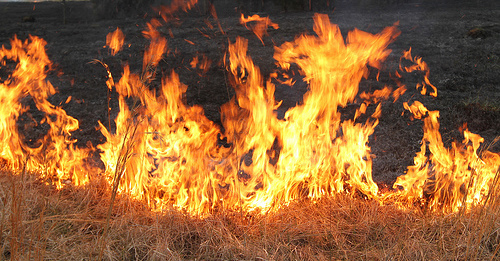Hunters and landowners alike often look for quick-fixes when it comes to white-tailed deer management. However, nothing is better than good old fashioned habitat management for maintaining and enhancing vegetation that is favorable for deer. Of all the possible management activities, one of the most beneficial and most overlooked management practice is prescribed burning.
Often referred to as controlled burning, prescribed burning is almost a one-stop shop for maintaining habitat in areas that already have above average deer vegetation. Burning carried out under a managed situation can eliminate excessive brush, stimulate the growth of beneficial plants, return nutrients tied up in dead material back into the soil, and increase the palatability and protein content of native plants. Below are some tips to think about when you plan on using prescribed burning for wildlife and habitat management.

First, having someone experienced in prescribed burning really helps. If you can have at least 10 people you will have more help and more eyes and boots on the ground. More is ideal, and the more the better. Second, burn a 15 to 20 yard perimeter (black line) around the area you intend to burn. Do this prior to the burn to hopefully keep the fire from jumping.
Third, do not ever plan on burning your entire property in a single year. You’ll give the deer nothing to eat, since most burns usually take place in the winter. If you burn all the food, there will be nothing for them to eat. Burn only about 1/5 to 1/3 of the property in any year.
Fourth, don’t burn the same sections consecutive years. Usually wait 3 to 5 years before burning that area again to allow certain forbs to sprout and avoid killing out your forbs completely. It will also allow beneficial browse species to recover and put on some very high quality nutrition for several years. Most browse plants only need to be burned about every 4 to 5 years. Like one fellow that burns regularly stated:
“Lastly, and most importantly, have a lot of water. We mix in a little soap as a surfactant that helps kill the fire quickly. We run 2 4-wheelers with 50 gallon sprayers, a mule with a 50 gallon sprayer, a 4X4 truck with a 2,000 gallon hose and another 4X4 with a 3,000 gallon tank and hose that would rival a firetruck’s. That’s what it takes with 4-5 others lighting on the ground.”
Fire is a great tool for deer management. If you have never burned before, first find someone who is experienced at conducting controlled burns and volunteer to help. I can guarantee that they will not turn down extra help. You will gain valuable experience and you will also be able to ask if they can help with your prescribed burn, too. Deer and wildlife management means working with the habitat on your property. Sitting back and watching it grow up is not management.